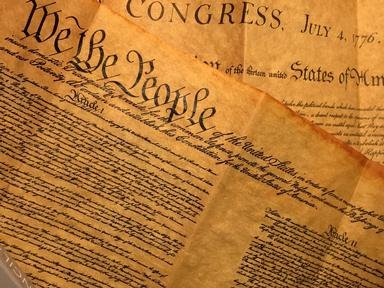Quiz Answer Key and Fun Facts
1. The text of the Equal Rights Amendment to the U.S. Constitution states: "Equality of rights under the law shall not be denied or abridged by the United States or by any state on account of sex."
2. Who originally wrote in 1923 the Equal Rights Amendment (ERA), intended to guarantee equal rights and equal protection for women, as the Fourteenth Amendment did for African Americans?
3. The Equal Rights Amendment was introduced in every session of Congress, without fail, between 1923 and 1972.
4. Who was the first President of the USA to ask Congress to pass the Equal Rights Amendment?
5. The National Woman's Party supported the ERA from the 1920s onward. Then what group of the women's liberation movement of the 1960s (the Second Wave of feminism) also made the ERA one of its top priorities from the start?
6. Congress passed the Equal Rights Amendment in 1972, when it was sent to the states for ratification. Which state was the first to ratify the ERA?
7. Which U.S. First Lady was a vocal supporter of the ERA, at times to her husband's chagrin?
8. For a constitutional amendment to become law in the USA, three-fourths of the States must ratify it in their legislatures. How many of the 38 necessary states had ratified the ERA by the March 1979 deadline imposed by Congress?
9. At first the ERA moved quickly through the states. Then in the late 1970s, the ERA faced organized opposition, especially from a band of conservatives. Who led the most prominent of the anti-ERA organizations?
10. Along with STOP-ERA and Christian fundamentalists, other groups opposed the ERA during the crisis period, 1978-1982, when the ERA was on the cusp of becoming law. Which was NOT one of these groups?
11. Which major U.S. political parties supported the Equal Rights Amendment between its introduction and its passage by Congress?
12. Congress voted to extend the deadline for ratification of the Equal Rights Amendment to 1982. By that time, several states had NEVER ratified the ERA, not even in one legislative house. Which ones?
13. Let's jump ahead a few decades. What Supreme Court Justice stated in 2010 that he or she did not believe the Constitution protects against sex discrimination?
14. How many states possessed a version of the Equal Rights Amendment in their STATE constitutions by the 2010s?
15. Since the early 1980s, there has been no effort in Congress to amend the U.S. Constitution to provide women equal protection under the law.
Source: Author
gracious1
This quiz was reviewed by FunTrivia editor
bloomsby before going online.
Any errors found in FunTrivia content are routinely corrected through our feedback system.

